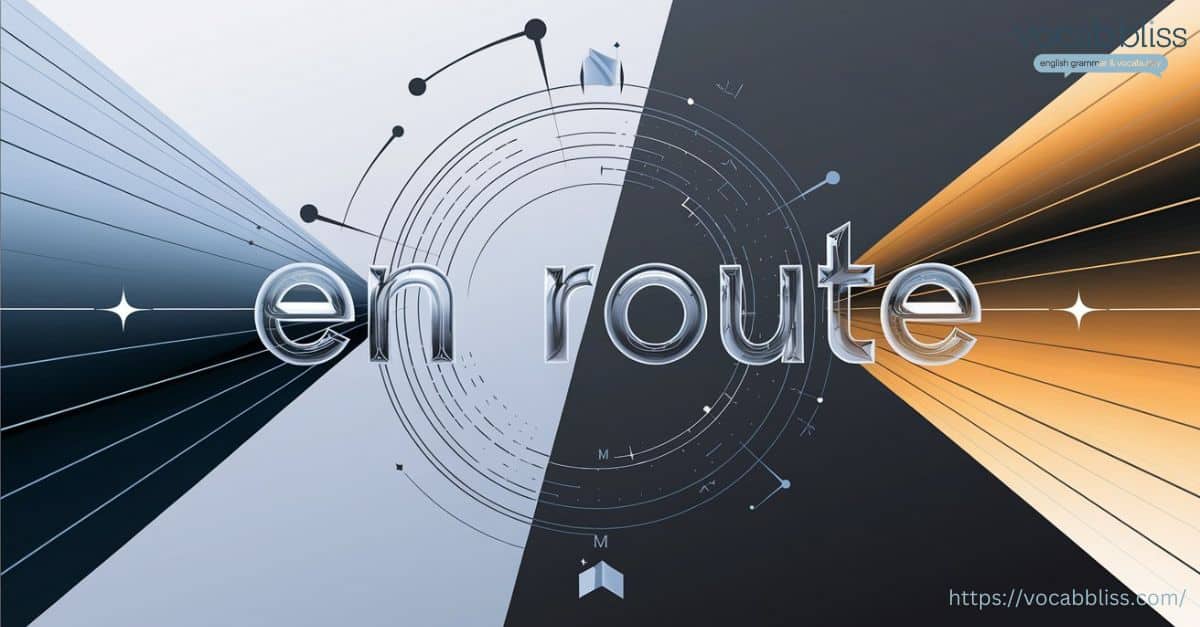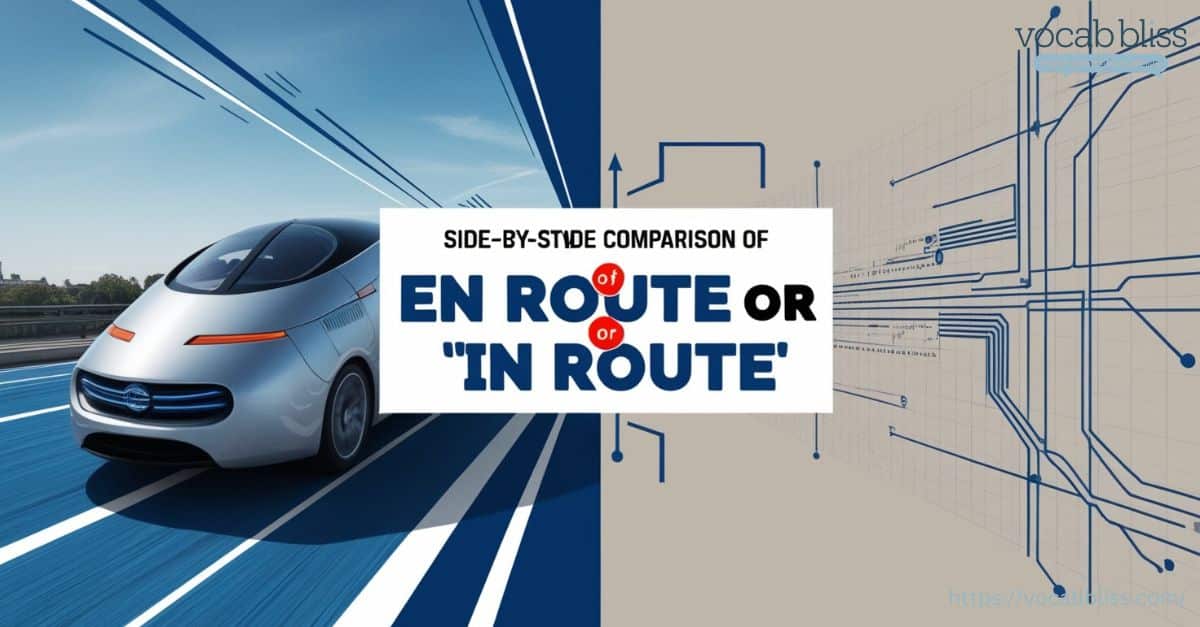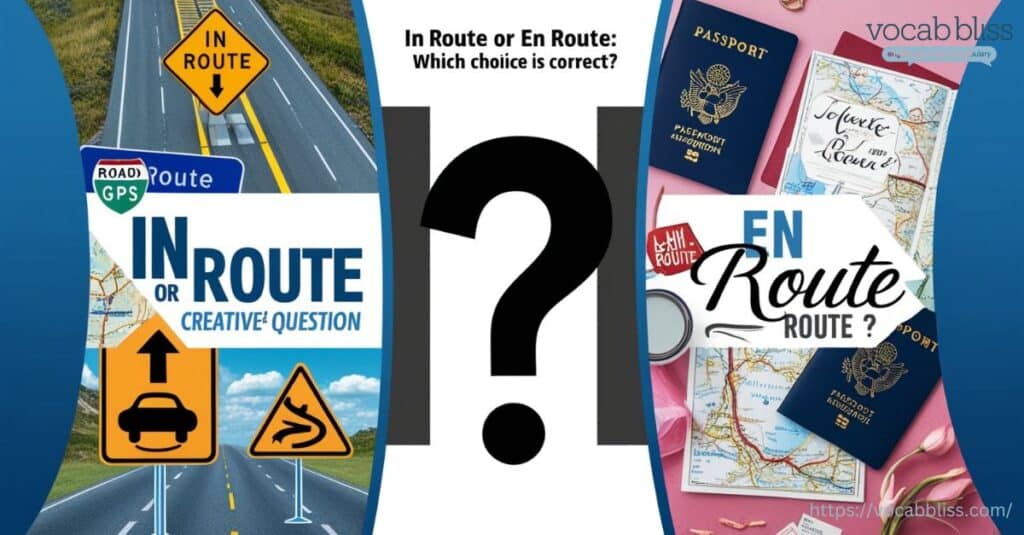When writing or speaking English, “in route or en route” often cause confusion due to their similar pronunciation. But only one of these is the correct phrase, and understanding its proper usage is essential for clear communication.
This guide explores the meaning, usage, and differences between these phrases, along with practical examples and helpful tips, ensuring you always choose the right one.
⚡ Quick Summary
Understanding the distinction between “in route or en route” is crucial for clear and accurate communication. Specifically, the phrase “en route” is the correct term, as it is derived from French and means “on the way” or “in transit.” It is widely accepted in both formal and informal contexts, appearing frequently in travel, logistics, and everyday conversations. On the other hand, “in-route” is a common error often caused by phonetic confusion or lack of familiarity with the original phrase. By learning the proper usage of “en route” and, at the same time, recognizing the common traps that lead to misusing “in route,” you can significantly enhance the precision and professionalism of your language.
Discover more: Afterward vs Afterwards: Is there any variation?
Breaking Down “in route or en route”
Although they sound alike, “inroute or enroute” are not interchangeable. The former is a borrowed term from French that means “on the way,” while the latter is an incorrect phrase commonly mistaken for its proper counterpart.
This distinction may seem small, but knowing the difference can help avoid embarrassing errors in formal or professional contexts.
What Does “En Route” Mean?
Definition of “EnRoute”

The phrase “enroute” originates from French, where “en” translates to “on” or “in,” and “route” means “road” or “path.” Together, therefore, “enroute” signifies being “on the way” or “in transit.” It was adopted into the English language during the 18th century, maintaining its original spelling and pronunciation.
Etymology of “EnRoute”
- French Roots: Directly borrowed from French, “enroute” is one of many French expressions that have seamlessly entered English vocabulary.
- Evolution in English: Its use expanded beyond literal travel to describe movement toward goals or destinations in various contexts.
Proper Definition and Grammatical Role
In English, “enroute” is primarily used as an adverbial phrase, which, in turn, modifies verbs to indicate movement toward a location or objective.In addition, it can describe both physical and figurative journeys, making it a versatile expression in various contexts.
For example:
- “She is en route to the meeting.”
- “The shipment is en route to its destination.”
When to Use “En Route”
Situations Where “EnRoute” Is Correct
Use “enroute” whenever describing physical or figurative movement toward a destination. This can apply to:
- Travel: Referring to people, vehicles, or goods in transit.
- Progression: Describing the advancement of an action, goal, or process.
Role in Formal and Informal Communication
“Enroute” is versatile, fitting both formal and informal settings:
- Formal Contexts: Logistics, aviation, and professional writing often use “enroute” to indicate travel or delivery. For instance:
- “The documents are enroute to the client.”
- “Flight 502 is enroute to Chicago.”
- Informal Settings: Casual conversations frequently use it when discussing personal travel or plans. For example:
- “I’m en route to the store—do you need anything?”
Examples of “En Route” in Sentences
- “I stopped for gas while enroute to the beach.”
- “The package is enroute and should arrive by tomorrow.”
Examples from Professional Contexts
- Logistics: “The shipment is enroute to the warehouse and is expected by noon.”
- Aviation: “The pilot reported smooth conditions while enroute to the destination.”
- Military: “The troops are enroute to their deployment location.”
Broader Usage
Beyond literal travel, “enroute” is used metaphorically:
- “The project is enroute to completion.”
- “Their team is enroute to achieving record profits.”
By understanding its meaning and appropriate contexts, you can use “enroute” confidently in both speech and writing.
What Does “In Route” Mean?
InRoute Definition

The phrase “inroute” is not recognized as correct English. It is a common error stemming from the misinterpretation of “en route.” While it might appear logical based on English prepositional structure, “inroute” lacks the grammatical validity and historical background of its French counterpart.
Why Is It Incorrect?
- Typographical Error: Many instances of “inroute” are simply typographical mistakes, especially in informal writing.
- Phonetic Confusion: The similarity in pronunciation between “en” (French) and “in” (English) leads to mishearing and subsequent misuse.
- Lack of Awareness: Non-native speakers or individuals unfamiliar with “enroute” as a borrowed French term may, as a result, default to the more familiar English structure.
For example, someone might mistakenly write:
- “The package is inroute to your location.”
This substitution is incorrect, as “enroute” is the proper term.
When Do People Use “In Route”?
Despite being grammatically wrong, “inroute” frequently appears in casual conversation, text messages, or informal documents. Here’s why:
Examples of Incorrect Usage in Informal Contexts
- Text Messaging:
- “I’m inroute to the party, be there soon.”
- “Your delivery is inroute, expected to arrive at 5 PM.”
- Social Media:
- “Inroute to my vacation spot!”
- Emails or Reports:
- “The team is inroute to the conference location.”
Frequent Misunderstandings
- Assuming “in route” aligns with English grammar: People assume the preposition “in” works with “route,” forming a phrase they believe makes sense.
- Overlooking the foreign origin of “enroute”: Lack of familiarity with French-origin phrases leads to incorrect substitutions.
Examples of “In Route” in Sentences
To help readers spot and avoid errors, here are examples of incorrect usage of “iroute”:
Common Mistakes:
- “The repair technician is inroute to your home.”
- “We’re inroute to the airport.”
Professional Settings:
- “The shipment is inroute to the customer’s warehouse.”
- “The team is inroute to finalize the project.”
Why These Are Wrong:
In each of these examples, “in route” should, therefore, be replaced with “enroute” in order to correct the grammar and effectively convey the intended meaning.
By understanding why “in route” is incorrect and learning to spot its misuse, you can, therefore, ensure your communication remains precise and professional. Furthermore, by opting for the correct term, “enroute,” you can easily avoid these common pitfalls.
Side-by-Side Comparison of “En Route or In Route”

To clarify the differences between “en route or in route,” here’s a detailed comparison table. This visual format highlights key aspects such as spelling, meaning, grammatical role, and examples, making it easy to distinguish between the correct and incorrect phrases.
| Feature | En Route | In Route |
|---|---|---|
| Spelling | EnRoute | InRoute |
| Meaning | On the way; in transit | Non-standard phrase; often a typo or error |
| Grammatical Role | Adverbial phrase used to describe movement toward a destination | Does not have a valid grammatical function |
| Origin | Derived from French, meaning “on the road” | Incorrect interpretation of the French term |
| Usage Context | Formal and informal; widely accepted in English | Informal; commonly misused in casual writing |
| Example (Correct) | “The package is enroute to its destination.” | ✘ N/A |
| Example (Incorrect) | ✘ N/A | “The package is inroute to its destination.” |
| Professional Acceptability | Correct and appropriate in all contexts | Incorrect; may lead to misunderstandings |
Key Takeaways from the Comparison
- Spelling Matters: Always use “enroute” in formal and informal writing.
- Professional Settings: Avoid “in route” in emails, reports, or presentations to maintain credibility.
- Origin Awareness: Remember that “enroute” is borrowed from French, preserving its original spelling and meaning in English.
This side-by-side table, therefore, provides a clear distinction, ensuring that you can confidently identify and use the correct phrase in any context.
Everyday Usage Examples
Mastering the proper use of “enroute” in daily communication can enhance clarity and professionalism. Below are practical examples of how to use the phrase correctly, as well as common traps to avoid the incorrect phrase, “in route.”
Practical Phrases for Using “En Route” Correctly
Travel and Logistics
- “The package is en route and will arrive by tomorrow.”
- “The flight is currently enroute to New York.”
- “I’m en route to the hotel—should be there in 20 minutes.”
Professional Settings
- “The documents are en route to the legal team for review.”
- “The shipment is en route to the distribution center.”
- “The ambulance is en route to the hospital.”
Everyday Conversations
- “I’ll grab lunch en route to your place.”
- “They stopped for coffee while en route to the game.”
Figurative Usage
- “Her career is en route to great success.”
- “The project is en route to completion ahead of schedule.”
Highlighting Common Traps That Lead to Using “In Route”
Many errors occur due to misunderstandings or a lack of familiarity with the term “en route.” Below are common scenarios where people mistakenly use “in route” and how to avoid these traps:
Mishearing “EnRoute” as “InRoute”
- Incorrect: “The driver is inroute to the pickup location.”
- Correct: “The driver is enroute to the pickup location.”
Assuming “In Route” Is Proper English
- Incorrect: “The team is inroute to the conference.”
- Correct: “The team is enroute to the conference.”
Typographical Errors in Writing
- Incorrect: “The goods are inroute to the warehouse.”
- Correct: “The goods are enroute to the warehouse.”
Overlooking Contextual Fit
Some writers assume “inroute” fits better in English prepositional structures, but this is incorrect. Always default to “enroute.”
By practicing these correct examples and, furthermore, avoiding common pitfalls, you’ll consistently use “enroute” correctly in everyday communication.
Quick Tips to Remember the Difference
- Think French: Recall that “enroute” is derived from French and retains its original spelling.
- Mnemonic: Remember that the “e” in “enroute” matches the “e” in “English,” making it the proper term.
- Proofread: Check for typos if you find yourself typing “inroute.”
By following these tips, you can avoid common errors and confidently use the correct phrase in writing and speech.
Conclusion “en route vs in route”
The correct usage of “in route vs en route“ highlights the importance of precision in language. While “enroute” is the proper term with a rich linguistic history, “inroute” is simply a mistake born out of misinterpretation.
Whether discussing travel plans, professional shipments, or progress toward a goal, using “enroute” correctly ensures your communication is clear, polished, and accurate. Next time you describe a journey or movement, remember this: you’re always enroute, not inroute..
Continue reading:
- Feal vs Feel: Which One Should You Use?
- Lended or Lent: Which One Fits Best?
- Onsite or On-Site: Examining Fundamental Variations
- Axle or Axel: What’s the Difference?

Jorge Phillips is an experienced blogger who writes for Vocab Bliss, sharing his passion for the English language. With a knack for simplifying complex grammar rules and a focus on commonly confused words, Jorge helps readers navigate the nuances of English with ease. His insights aim to make learning engaging and practical.







